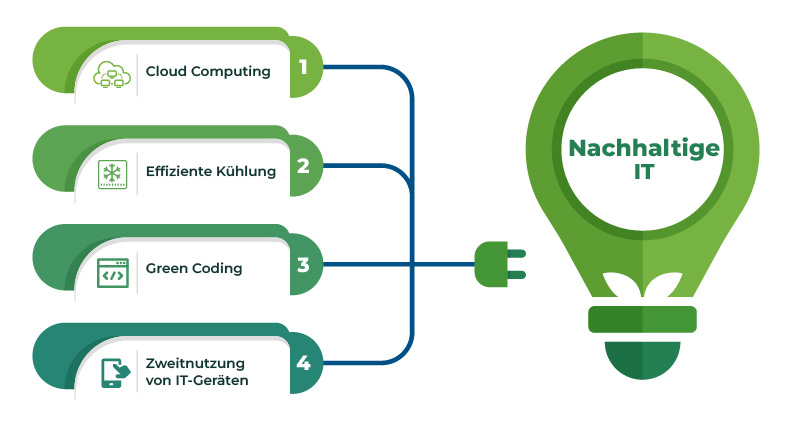Green IT: How software can contribute to sustainability
Awareness of the share of IT in global CO2 emissions is growing – as are efforts to make information technology more sustainable. With the right strategy, hardware and software can make a significant contribution to sustainability. You can read what characterizes Green IT and how companies can become more sustainable in the following article.
What is sustainable IT?
The terms sustainable IT or Green IT refer to all efforts to achieve greater resource efficiency in the use of information technology in companies. The central goals are a significant reduction of the CO2 footprint and the lowest possible environmental impact. The strategic approaches of sustainable IT extend across the entire life cycle of information and communication technology. The focus of action is on the following points:
- Recycling, environmentally friendly disposal and better waste management
- Reduction of energy consumption and reduction of CO2 emissions in use and production
- Sustainable product design and use of durable hardware
- Use of modern, energy-saving software
- Focus on renewable energy when operating IT equipment
- Conversion to paperless work as much as possible
Sometimes ethical and social aspirations (e.g. fair working conditions) are also seen as characteristics of sustainable IT. These are however usually classed as Fair IT.
Expanding IT infrastructure – increased CO2 emissions
About 2 percent of all global CO2 emissions come from the field of information and communication technology. And this number is increasing. Many companies are not even aware of the climate-relevant effects of corporate IT. The CO2 emissions caused by IT, fueled by the digitization driven by the pandemic, have increased massively in the recent months. In principle, when IT infrastructures expand, so do CO2 emissions.
Advantages of sustainable IT solutions
Companies would do well to have a look at Green IT. If only because the political and social pressure on IT climate sinners is growing. Companies that implement sustainable IT solutions and aggressively communicate the active reduction of CO2 emissions benefit from a significant image upgrade, which has a positive impact on both sales and recruiting.
Also: In the medium and long term, investments in sustainable solutions are almost always financial gains. The reduction in energy consumption, the use of recovered heat and the purchase of more energy-efficient devices make a significant contribution to lowering operating costs.
Becoming more sustainable: This is what companies can do
Under the key term life cycle engineering, intensive research has been carried out into sustainable IT solutions for several years. Companies that develop their own sustainability strategy quickly realize that measures to improve resource and energy efficiency can be implemented with little investment. Here we shall point out four promising fields of action.

Cloud computing
Thanks to cloud computing solutions, many companies can do without their own servers. This streamlining of your own IT is also good for the environment, as the data centers of certified users work much more efficiently. By using cloud solutions, corporate IT can access the same computing power with a much lower energy consumption.

Efficient cooling
The energy consumption of data centers is gigantic. After all, the servers have to be cooled permanently, which requires a lot of energy. Efficient cooling is therefore one of the most important parameters on the way to Green IT. Instead of cooling large rooms completely, cold and warm air can be separated and routed directly to the respective servers. The waste heat can in turn be used to heat the offices. The use of water – a far more efficient coolant than air – is also possible in special circulation systems.

Green coding
The influence of software on sustainability is underestimated in many companies. Many solutions consume a not inconsiderable amount of energy. The use of software that has been programmed according to green criteria therefore helps to improve the ecological footprint. Appropriately designed software is often referred to as Green coding. Prominent environmental seals such as the Blue Angel or the EU Ecolabel can also be used as an important decision aid for the choice of software.

Re-use of IT equipment
While many IT companies change their devices every two years and replace them with more powerful computers, older devices are often sufficient for the IT of smaller companies. The targeted recycling and re-use of IT devices is not only financially beneficial, it also actively helps to save resources.
Green IT – an important pillar for more sustainability
The implementation of sustainable IT solutions is interesting for companies of all sizes. A corresponding orientation can protect the environment and climate, improve the brand image and save operating costs. For many companies, however, IT is not the only way to improve energy efficiency. Depending on the industry, there are different focal points on the way to more sustainability. In mechanical engineering, for example, there are a number of measures that can be used to achieve greener production. In our next blog post, we will therefore focus on sustainability in mechanical and plant engineering.
Sustainable IT also plays an important role at XPLM. In addition to planning further measures, we have centralized our server landscape and thus reduced the number and power consumption of the computers. In addition, our employees use their computers over a longer period of time, thereby saving resources such as precious metals and rare earths.
